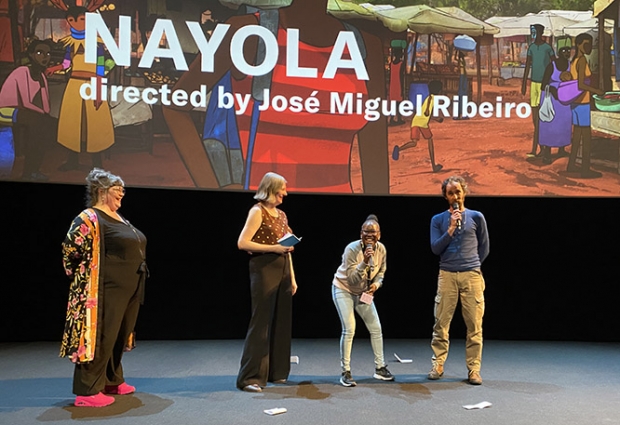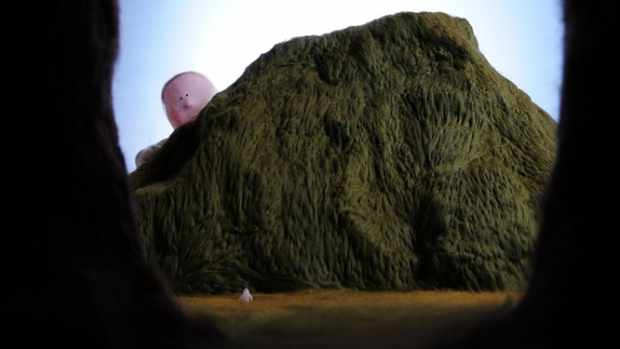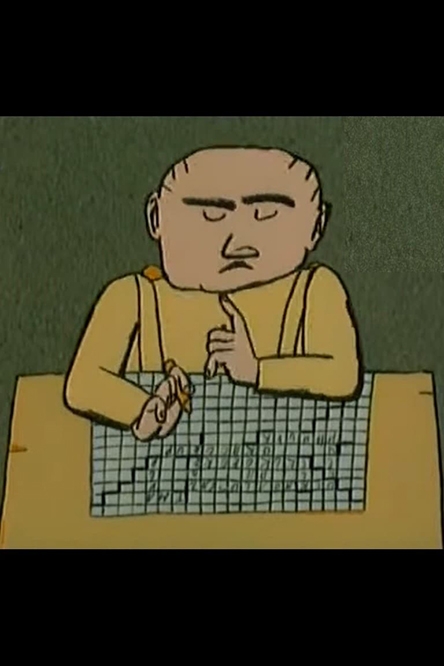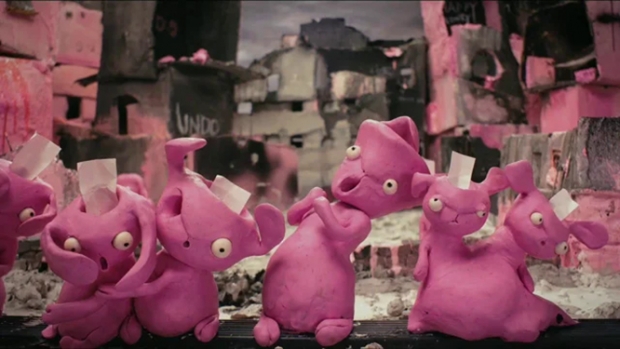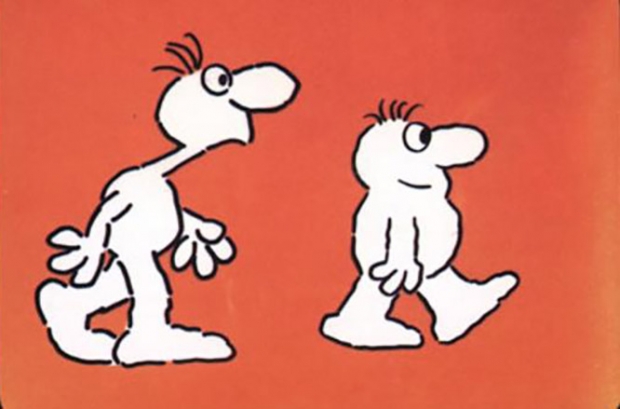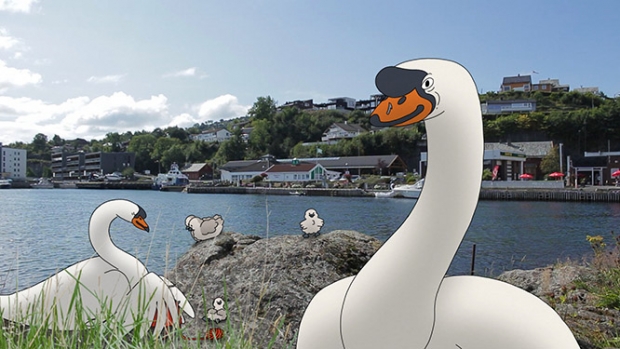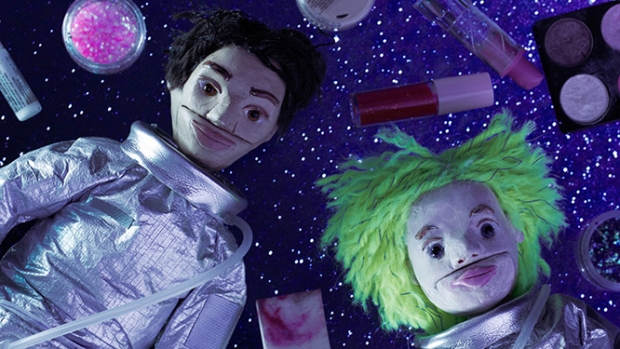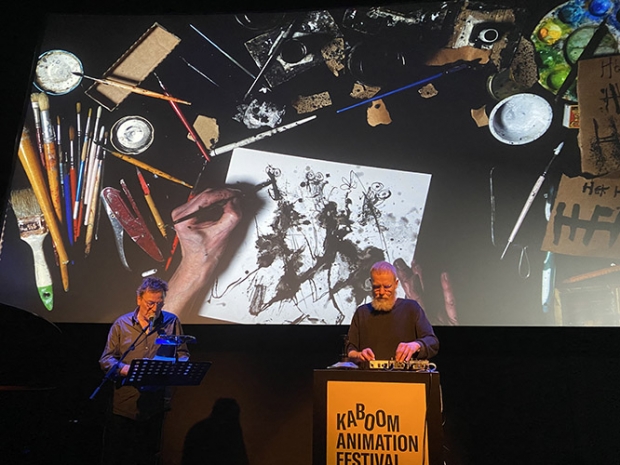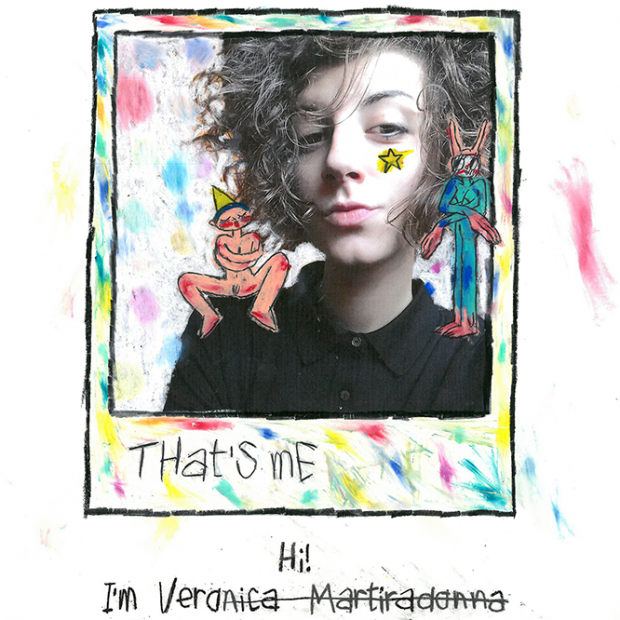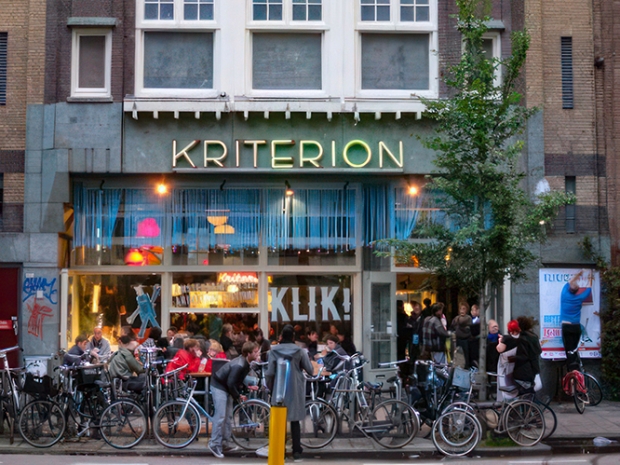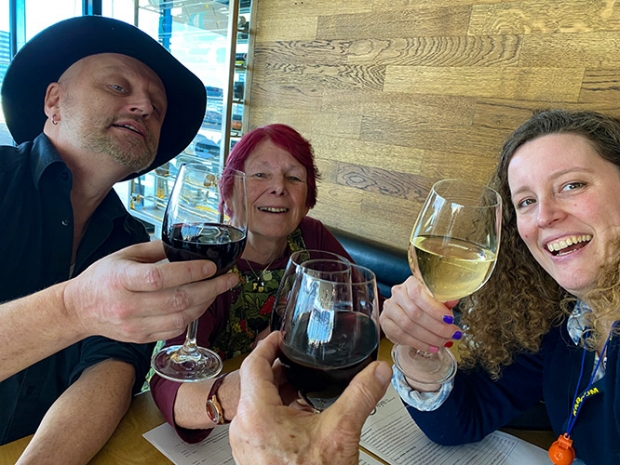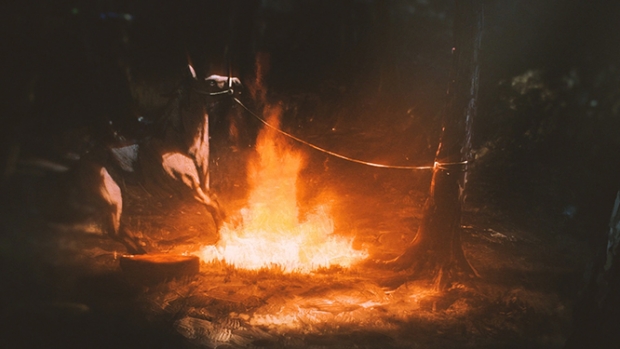Kaboom Animation Festival has a split personality.
Kaboom Animation Festival has a split personality. The first four days of the festival are held in Utrecht and are primarily devoted to professional days for The Netherlands film industry. Then the festival moves 47,8 kilometers up the road to Amsterdam to the beautiful Eye, home of the Museum for Film and Moving Image, for another four days of festival fun. This means that the festival had two opening nights.
Kaboom kicked off in Utrecht with a unique audiovisual tour of the city. The Hamburg-based collective A Wall is a Screen has been transforming walls and other structures around the world into screens as part of its short film and animation walks. Only the starting point was known by the audience. The films and locations were a surprise. The audience followed the projection team from location to location, a splendid way to open a festival.
For the Amsterdam opening the audience was back in the screening room at The Eye. We were treated to Portuguese animator Jose Miguel Ribeiro’s first feature film, Nayola. The film is a moving, thought-provoking depiction of three generations of Angolan women marked by the long civil war the country suffered at the end of the last century. The film has won numerous awards including Best Feature Film at the prestigious Quirino Awards, an annual event that honors the best Spanish, Portuguese, and Latin American animation.
The theme of this year’s Kaboom was Beyond Perfection. First films by animators who go on to become masters of their craft are not shown very often. Although they may not be the works of genius that their later films achieve, it is interesting to see how their careers began.
The Start Me Up: Debuts of Masters screening took the audience back to the beginning for acclaimed animators Paul Driessen, Michael Dudok de Wit, Emma Swaef, Gil Alkabetz, Julia Pott, Evert de Beijer, Alison Snowden, Monique Renault, Georges Schwizgebel, Koji Yamamura, Michaela Pavlatova, Sabrina Nihei, Regina Pessoa, and Signe Baumane. Quite an impressive roster of animators!
Before Emma Swaef and partner Marc James Roels created the multi-award-winning Oh Willy, Emma introduced us to Willy in her 2008 film Soft Plants. In the film, chubby office worker Willy rides through the forest, naked, on the back of a sheep. His body is still in the office, but his mind wonders between dangerous flowers and an imaginary friendship with a soft sheep. I had never seen this film before and it was interesting to see the “birth” of Willy.
I am always entertained by Czech Republic animator Michaela Pavlatova’s feminist approach to relationships and sex. Before her Academy Award nomination in 1992 for Reci, Reci, Reci, she made The Crossword Puzzle in 1989. The film is a domestic farce that unfolds as a woman tries to assert her sexual needs. She is driven to despair by her husband who is completely absorbed in his crossword puzzle and not paying any attention to her. Every film in the Debut of Masters program was a little gem. They all deserve to be seen more often.
Another program in the Beyond Perfection screenings, Everything Everywhere Perfect All At Once, featured two films that I am very fond of, Rabbitland and Learning To Walk. In their 2013 film Rabbitland, Ana Nedelijkovic and Nikola Majdak, Jr. from Serbia created a “perfect world” where rabbits live. They are shocking pink in color, have holes in their heads, and are happy regardless of what happens to them. They have reached the highest state of evolution that has ever been achieved. Their life is completely fulfilled and they are always happy. The rabbits spend their days lining up to vote in free and democratic elections, which take place once a day, every day because Rabbitland is an ordered democracy. In the end, we discover that the elections are organized by the “Evil Girls”, just for their own amusement.
Rabbitland is dripping with dark humor and irony. It is also a bit too close to the truth of what is happening in many parts of the world today. The film won numerous awards including the Crystal Bear at the Berlinale. Ana and Nikola are now working on their first feature film. The rabbits will return to New Rabbitland.
In 1978 the legendary Croatian animator Borivoj Dovnikovic, better known as Bordo, created Learning to Walk. Using simple drawings, often on plain backgrounds, his films frequently portrayed the plight of the “little man”. In Learning to Walk, Svojislav is used to walking the way he was taught to walk by his mother. His four friends, each convinced that theirs is the only way to walk, try to teach him their style of walking. Svojislav has a difficult time getting away from his friends, but once he does he continues to happily walk the way his mother taught him. Bordo sadly passed away in 2022, but he has left us with a collection of wonderful films and his work lives on.
Kaboom Animation Festival doesn’t have a separate student film category. Working on the principle that a good film is a good film, student films are part of the regular competition. In the twenty-five films that made up the two Dutch shorts competition programs, twelve of them were made by students. The future of Dutch animation looks bright.
The two programs of short documentary films in competition included some of my favorite films. Two recent graduates of Volda University in Norway, Mia L. Henriksen and Konrad Hjemli, created The Harbormaster. The film starts out as a sweet story about a beloved small-town male swan who is an icon around the town’s harbor. Throughout the seven-minute film, he becomes a wanted criminal. Going from loving mate and father to a menace to the community, he begins to attack people on land and in the water. The Harbormaster as he is called becomes the scourge of Animal Control.
Based on a true story, The Harbormaster met a sad end when local authorities decided to put him down after he attacked a group of daycare children and dragged a little girl into the water. The story of his planned euthanasia stirred up Norway’s most polarizing debate in 2017. Using a mixture of live-action footage and animation, the film raises many questions about how wild animal life living in cities should be treated.
Also in the Short Docs program was Blush – An Extraordinary Voyage by Iiti Yli-Harja who specializes in documentary puppet animation. For 18-year-old Finnish/Kosovan Fatua, a simple visit to the grocery store feels as nerve-racking as a lunar expedition. For the first time in his life, he is wearing make-up out in public. Luckily his best friend Rai, a young woman who is slightly autistic, is there to ferociously support him from blast off, landing, and the return voyage.
Iiti’s puppets are roughly made and fit the characters in Blush -An Extraordinary Voyage perfectly. Her portraits of Fatua and Rai are an excellent reflection of the traumas and dilemmas that so many young people are facing today.
If you needed a good laugh after facing too much real life in Short Docs, Bonkers Shorts was the place for you. From a giant feline in Andre Almeida’s Carisfaction to Thomas Stellmach’s hilarious The Sausage Run, the late-night adult program was a great opportunity to sit back, laugh, and watch films that you didn’t have to think about too much or search for a deeper meaning in them.
One of the most entertaining events at Kaboom was a live performance by the band Money For Your Whale who improvised live music while animator/illustrator Sjaak Rood drew what he heard. Nothing was rehearsed or planned in advance. At this entertaining performance, Rood and the musicians let us “hear” what drawing sounds like. Not only did we see the images that Rood was drawing reflected on the big movie screen, but the sounds that the artist made also influenced the performance.
Singer and voice artist Han Buhrs performed his own lyrics in existing and invented languages. By adding rubbers, clothes pins, magnets, and some unidentifiable objects to his piano strings, Albert van Veenendaal created some unique, otherworldly sounds with a wide variety of timbers. Last, but far from least, Robert van Heumen captured all of the sounds live, which he then manipulated and added back into the performance. It was an extremely unique event that both Nik and I thoroughly enjoyed.
Kaboom is the perfect mixture of silly fun and serious film watching. You could go from a program of Poetry in Motion to getting a permanent tattoo, all in the space of a couple of hours without ever leaving the Eye.
Poetry in Motion took viewers way off the beaten track with such films as King’s Garden by noted Iranian director Iraj Mohammafi Razini. The film is a tragic fairy tale about a lover who goes to the King’s garden to pick red roses to win the heart of a young lady. The film was created by moving pine tree needles on a backlit piece of glass which gives a strange silhouette effect.
The tattoo artistry was provided by the talented animator/tattoo artist Veronica Martiradonna. Along with her skin artistry, Veronica is known for her graduation film Underwater Love which screened at Annecy and many other festivals.
Kaboom festival is very near and dear to my heart. I have been a part of the festival since 2008. During those early years, it was known as KLIK and held at the student-run Kriterion Theatre. In those days everyone would have gotten a big laugh at the thought of the festival ever being held at the prestigious Eye Film Museum.
Three years ago the festival gave me the great honor of bestowing The Nancy Award upon any film in competition of my choice. Along with a trophy the winner gets to go wine tasting with me at the next edition of the festival.
Last year I presented my award to Jantiene de Kroon and Remco Polman for their dystopian thriller Camouflage. The film follows office clerk Amouf as he desperately tries to hold his life together while the world around him gets darker and darker as a brutal regime systematically prosecutes certain groups of people. Sounds familiar doesn’t it? This year at the festival Nik and I had a lovely time and good conversation with Jantiene and Remco over several glasses of very nice wines.
My 2023 award went to David Doutel and Vasco Sa for their haunting 14-minute film Garrano. David and Vasco have made four films together and each one grows stronger, more intense, and delves deeper into loss and sorrow. Their films are inspired by events in their native Portugal but are universal in the tragedies that they portray.
Garrano was inspired by the forest fires that raged through Portugal in 2018. Garrano is the name of an ancient breed of horse from Northern Portugal. I have seen the film several times and it never fails to move me. A complete list of the winning films is at the end of this article.
A big thank you goes to Aneta Ozorek and Annabet Langkamp, co-directors of the festival. Also to Head Programmer Maarten van Gageldonk who lets me be one of the film reviewers and always answers my questions right away. A big congratulations to all of the festival staff and volunteers for another successful festival. See you next year at Kaboom! - 4 to 14 April 2024.
If you want to learn more about the festival and how to submit your film for the 2024 edition go to: www.kaboomfestival.nl
The Awards
- Best Short – ‘Skinned’ by Joachim Herisse
- Best Student Short – ‘Goodbye Jérôme!’ by Adam Sillard, Gabrielle Selnet & Chloé Farr
- Best Documentary – ‘The Heights’ by Alejandro Salgado
- Best Dutch Short – ‘Questbound: Forbidden Ventures of the Undead Soul’ by Owen Buckley & Alexander Bierling
- Best Music Video – ‘How Many’ by Bianca Scali
- Best VR – ‘From the Main Square’ by Pedro Harres
- Jamie Bolio Award – ‘Ice Merchants’ by João Gonzalez
- Audience Award for Best Short – ‘Freedom Swimmer’ by Olivia Martin-McGuire
- Audience Award for Best Experimental Short – ‘Fur’ by Zhen Li
- Audience Award for Best Commissioned Short – ‘An End to War Enough’ by Simone Massi
- Audience Award for Best Children’s Film – ‘Momo’ by Erik Verkerk & Joost van den Bosch
- Audience Award for Best Feature – ‘Blind Willow, Sleeping Woman’ by Pierre Földes
- Nancy Award – ‘Garrano’ by David Doutel & Vasco Sá


